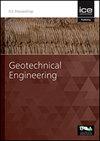Groundwater pressure induced failure of sprayed waterproof membrane interface in tunnels
IF 1.7
4区 工程技术
Q3 ENGINEERING, GEOLOGICAL
Proceedings of the Institution of Civil Engineers-Geotechnical Engineering
Pub Date : 2022-09-21
DOI:10.1680/jgeen.22.00111
引用次数: 2
Abstract
Groundwater pressure is the main cause of debonding (i.e., tensile failure) of the sprayed waterproofing membrane interface within composite sprayed concrete lined (SCL) tunnels. It is critical to understand the failure mechanisms, the right approach to numerically simulating its effects and the practical implications on lining design and membrane interface testing methodology. This paper answers these questions. The paper first presents a conceptual relationship between the possible groundwater pressure application locations and the stress state and hence potential failure mechanism of the membrane interface in composite SCL tunnels. To quantify stresses in the fully bonded membrane interface, two numerical modelling approaches for the membrane interface with different levels of complexity are introduced. Example numerical analyses of composite beams and whole composite SCL tunnels with fully bonded membrane interface are demonstrated. The results confirm the conceptual relationship between water application location and the stress state and potential failure mechanism of the membrane interface. The results also confirm the proposed two numerical modelling approaches are both able to simulate the effects of groundwater pressure on the stress states of membrane interface and tunnel lining forces. The implications on the tunnel design and testing programme for the sprayed membrane interface are discussed.隧道喷淋防水膜界面地下水压力破坏研究
地下水压力是复合喷射混凝土衬砌隧道中喷射防水膜界面发生脱粘(即拉伸破坏)的主要原因。了解破坏机制、正确的数值模拟方法以及对衬砌设计和膜界面测试方法的实际意义至关重要。本文回答了这些问题。本文首先提出了复合SCL隧道中可能的地下水压力施加位置与应力状态之间的概念关系以及膜界面的潜在破坏机制。为了量化完全结合膜界面的应力,介绍了两种不同复杂程度的膜界面数值模拟方法。给出了具有全粘结膜界面的组合梁和整体组合SCL隧道的数值分析实例。结果证实了施水位置与膜界面应力状态和潜在破坏机制之间的概念关系。结果还证实了所提出的两种数值模拟方法都能够模拟地下水压力对膜界面应力状态和隧道衬砌力的影响。讨论了喷膜界面对隧道设计和试验方案的启示。
本文章由计算机程序翻译,如有差异,请以英文原文为准。
求助全文
约1分钟内获得全文
求助全文
来源期刊
CiteScore
4.40
自引率
4.50%
发文量
68
审稿时长
3 months
期刊介绍:
Geotechnical Engineering provides a forum for the publication of high quality, topical and relevant technical papers covering all aspects of geotechnical research, design, construction and performance. The journal aims to be of interest to those civil, structural or geotechnical engineering practitioners wishing to develop a greater understanding of the influence of geotechnics on the built environment.

 求助内容:
求助内容: 应助结果提醒方式:
应助结果提醒方式:


